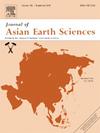马坑矽卡岩型铁多金属矿床含镓、锗矿物及富微量元素磁铁矿
IF 2.4
3区 地球科学
Q2 GEOSCIENCES, MULTIDISCIPLINARY
引用次数: 0
摘要
马坑矽卡岩铁多金属矿床是中国东部最大的铁矿床。它拥有丰富的铁和钼资源以及潜在的镓和锗副产品。然而,Ga和Ge在该矿床中的分布和富集机制尚不清楚。研究表明,Ga主要赋存于辉石、角闪洞和磁铁矿中,中位含量分别为180 ppm、24 ppm和22 ppm。锗优先富集于角闪石和角闪石中,中位含量分别为50 ppm和37 ppm。硫化物含有可以忽略不计的Ga和Ge。根据矿物组合,确定了4代磁铁矿(ⅰ~ⅳ)。镁-ⅰ主要与角闪石和辉石伴生,镁-ⅱ主要与角闪石和绿泥石伴生。iii型磁铁矿被黄铁矿取代或充填,iv型磁铁矿与磁黄铁矿、黄铁矿和萤石伴生。镁- i ~镁- iii的中位Ga和Ge含量分别为13 ~ 20ppm和4 ~ 15ppm。相比之下,magi - iv的Ga和Ge中位数含量分别为113 ppm和20 ppm。镓通过取代Fe2+/ Fe3+或Mn2+进入硅酸盐矿物,而Ge倾向于取代Si4+或Al3+。在磁铁矿中,Ga通过偶联替代(Ga3+ + Al3+↔2Fe3+)进入,而Ge通过同态替代(Ge2+↔Fe2+)或偶联替代(Ge2+ + Mg2+↔2Fe2+)并入。Ga和Ge在硅酸盐矿物中的富集与它们的晶体结构和高分配系数有关。ag- iv中Ga和Ge含量升高可能是富Ga和富Ge流体叠加的结果,同时温度较低,氧逸度较高。本文章由计算机程序翻译,如有差异,请以英文原文为准。

Ga- and Ge-bearing minerals and trace element-rich magnetite in the Makeng skarn Fe polymetallic deposit, Eastern China
The Makeng skarn Fe polymetallic deposit is the largest Fe deposit in Eastern China. It hosts substantial Fe and Mo resources alongside potential Ga and Ge by-products. However, the distribution and enrichment mechanism of Ga and Ge in this deposit remain poorly understood. Our study reveals that Ga is primarily hosted in pyroxene, amphibole, and magnetite with median contents of 180 ppm, 24 ppm, and 22 ppm, respectively. Germanium is preferentially concentrated in andradite and amphibole with median contents of 50 ppm and 37 ppm, respectively. Sulfides contain negligible Ga and Ge. Four generations of magnetite (Mag-I to Mag-IV) have been identified based on mineral assemblages. Mag-I is mainly associated with andradite and pyroxene, whereas Mag-II is associated with amphibole and chlorite. Mag-III is replaced or filled by pyrite, whereas Mag-IV is associated with pyrrhotite, pyrite and fluorite. Mag-I to Mag-III have median Ga and Ge contents of 13–20 ppm and 4–15 ppm, respectively. In contrast, Mag-IV shows higher median Ga and Ge contents of 113 ppm and 20 ppm, respectively. Gallium incorporates into silicate minerals by substituting for Fe2+/ Fe3+ or Mn2+, whereas Ge tends to replace Si4+ or Al3+. In magnetite, Ga enters via couple substitution, Ga3+ + Al3+ ↔ 2Fe3+, whereas Ge incorporates through either isomorphic substitution (Ge2+ ↔ Fe2+) or coupled substitution (Ge2+ + Mg2+ ↔ 2Fe2+). The enrichment of Ga and Ge in silicate minerals is attributed to their crystal structures and high partition coefficients. The elevated Ga and Ge contents in Mag-IV may result from the superposition of Ga- and Ge-rich fluids, along with lower temperature and higher oxygen fugacity.
求助全文
通过发布文献求助,成功后即可免费获取论文全文。
去求助
来源期刊

Journal of Asian Earth Sciences
地学-地球科学综合
CiteScore
5.90
自引率
10.00%
发文量
324
审稿时长
71 days
期刊介绍:
Journal of Asian Earth Sciences has an open access mirror journal Journal of Asian Earth Sciences: X, sharing the same aims and scope, editorial team, submission system and rigorous peer review.
The Journal of Asian Earth Sciences is an international interdisciplinary journal devoted to all aspects of research related to the solid Earth Sciences of Asia. The Journal publishes high quality, peer-reviewed scientific papers on the regional geology, tectonics, geochemistry and geophysics of Asia. It will be devoted primarily to research papers but short communications relating to new developments of broad interest, reviews and book reviews will also be included. Papers must have international appeal and should present work of more than local significance.
The scope includes deep processes of the Asian continent and its adjacent oceans; seismology and earthquakes; orogeny, magmatism, metamorphism and volcanism; growth, deformation and destruction of the Asian crust; crust-mantle interaction; evolution of life (early life, biostratigraphy, biogeography and mass-extinction); fluids, fluxes and reservoirs of mineral and energy resources; surface processes (weathering, erosion, transport and deposition of sediments) and resulting geomorphology; and the response of the Earth to global climate change as viewed within the Asian continent and surrounding oceans.
 求助内容:
求助内容: 应助结果提醒方式:
应助结果提醒方式:


